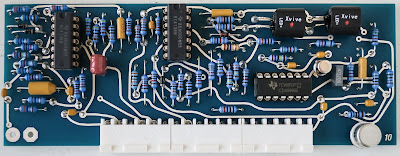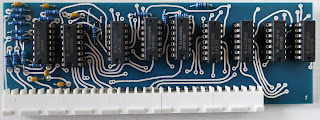Following traces has been added to this 2.1 version of motherboard PCB:
- trace between Molex 4A and Molex 3B
- trace between Program Card pin7 and via
- trace to Card 8 pin 11 instead of pin 12 is corrected by connecting these two pins on motherboard
- trace between SW8 and SW10
To change the trigger threshold (Pulser, Sequencer, Envelope Generator) from 10V to 5V I will change R56 to 150k.
To enable my 208 to communicate with iProgram card I must do the following modifications:
- connectors B and 2 are connected together and grounded to Q (quiet/analog ground)
- pin C is connected to +5V
- pins D and 4 are connected together and grounded to N (noisy/digital ground)
 |
| Photo by Modular Synthesis |




















